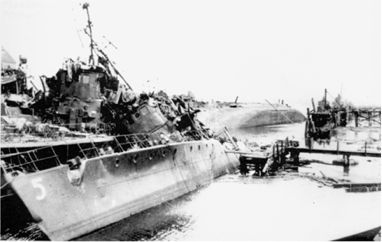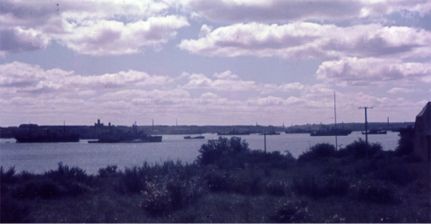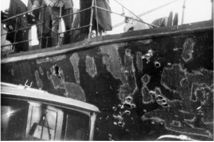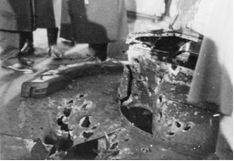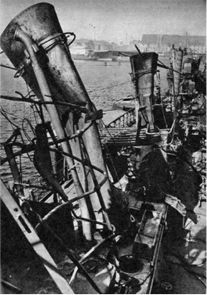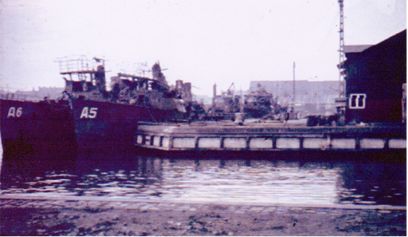|
You are here: 4Campaigns & Battles4Index4The Explosion in Flensburg (1945) |
||||||||||||||||||||||||||||||||||||||||||||
|
The Explosion in Flensburg (1945):Four former Danish Torpedo Boats are Destroyed in an ExplosionA further account of the destruction of the four Danish DRAGEN and GLENTEN Class torpedo boats. Immediately after the conclusion of the Second World War in Europe, the remaining Danish torpedo boats handed over to the Germans in 1941 were destroyed in an explosion in Flensburg. By Søren Nørby, M.A Hist. The Naval History Journal (Marinehistorisk Tidsskrift) #4, November 2002, included an article by the present author concerning the torpedo boats handed over to Germany in February 1941. In the article I described, among other things, how four of the boats were severely damaged as a result of a munitions explosion on board the tender DONAU in the port of Flensburg on June 14, 1945. I have subsequently received a detailed account of the events in Flensburg from retired commander Jørgen Strange, and have ascertained that my description of the events was not quite correct. I would therefore like to share the new information with the readers of the journal and this website.
Damaged ships in the port of Flensburg. In the
background the capsized tender DONAU. The account is written by the German Kapitänleutnant (Lieutenant Commander) Gerhard O. Richter (deceased). His business was involved after the war in the clear up following the explosion, which had scattered munitions over large parts of the port of Flensburg. Background After the German Capitulation in May 1945, the British Occupying Forces assembled many of the remaining German warships in the port of Flensburg. The British ordered the German crews to remove all ordnance from the ships, with the help of a group of former German soldiers who were now prisoners of war. All ordnance on board, from torpedoes, depth charges and artillery shells, to rounds of ammunition and signal flares, was to be taken ashore, from where it would be removed by British troops. The Germans were very efficient, and took the munitions ashore quicker than the British troops could remove it. Over the course of a few weeks a large stockpile of munitions had accumulated in a row of sheds by the port.
Ships at anchor in Flensburg fjord, Summer
1945. The explosion According to Richter's account, the first explosion occurred at ten minutes past eight on the morning of June 14, 1945. A shed in which 20 mm ammunition was being stored blew up, raining exploding munitions and pieces of burning shed down over a large part of the port. Barely ten minutes later, the next explosion occurred, which was far more powerful. This time a nearby shed, containing between 200 and 250 depth charges, blew up. The most common German depth charge contained approx. 125 kilos of explosives, so there is no doubt that this explosion must have been extremely powerful. The explosion started a chain reaction which caused the remainder of the surrounding sheds also to explode, in quick succession. The blast wave quickly spread over the area, leveling buildings in the port area and knocking over ships. The blast was so powerful, that roofs were ripped off in the town of Flensburg, and windows were shattered as far as 10 kilometers away! The British forces in Flensburg initially thought it was an attempted German mutiny and/or sabotage and therefore went on immediate alert, but they quickly realized that a major disaster had occurred. British forces quickly sprang into action to assist German firefighters and volunteers in putting out the fires. The work was hampered by the large quantities of unexploded munitions scattered over the port area. The Danish torpedo boats Close to the exploding sheds lay the tender DONAU, and close to that vessel, four of the Danish torpedo boats that had been handed over in 1941: TFA 1, 2, 5 and 6 (HØGEN, ØRNEN, HVALEN and LAXEN). The two remaining boats, GLENTEN and DRAGEN, had been lost in the Spring of 1945. The blast wave from the explosion ruptured the hull of the 4,260 tonne DONAU, causing her to capsize. The superstructures of the Danish torpedo boats were completely destroyed, and their hulls were severely damaged. Nonetheless, they remained afloat.
Pictures of the damage, taken after the boats
had been towed back to Holmen Naval Base in Copenhagen. In 1945 a small group of Danish naval personnel went to the North German ports to look for ships that had been taken from the Danes. According to a subsequent account by John Ahrentoft, who participated in the expedition, the Danes arrived in Flensburg only a few hours after the explosion had occurred. Among other things, here they found the Danish torpedo boats. Despite being severely damaged, they were subsequently towed back to Holmen Naval Base in Copenhagen. However, the Danish Navy gave up trying to repair them, and they were scrapped during 1949-52.
Damaged torpedo boats at Dokøen (Holmen Naval
Base) in 1945. What went wrong? The British subsequently set up a board of inquiry to ascertain the cause of the disaster. The board interviewed all survivors from the accident, and arrived at the following possible explanation: June 14 was the British King's birthday, and therefore a British public holiday. This meant that the munitions assembled would not be removed that day, but no-one had told the Germans. They therefore continued with the work of collecting and storing the munitions from the ships in the port, and as a consequence there was an exceptionally large amount of munitions in the sheds that day. Richter’s explanation of what may have happened demonstrates Murphy's law: "if it can go wrong, it will". During a demonstration to the German workers of how to handle the munitions collected, one of them accidentally primed a hand grenade. He then panicked and threw the grenade away from him – and it landed in the middle of a pile of signal flares and pistol ammunition. The officer in charge immediately ordered everyone to leave the building, after which he attempted to prevent the explosion. He was unsuccessful and died in the attempt. The explosion from the flares spread from there to some 20 mm shells, and that set off the chain reaction. There were 60 fatalities as a direct result of the explosion, of whom by far the greatest number were Germans. In addition, over 200 persons were injured, of whom a number later died. In total 88 persons are believed to have lost their lives. Even today, divers in the area encounter munitions, but it's not always possible to determine if they are from the munitions explosion or from the heavy Allied air raids which Flensburg suffered in the last year of the war. Translated by Alan Russel
- Do you miss a major event on this Site,
Are you able to contribute to the unfolding of
the Danish Naval History, You can also use the Naval Web Forum on this web-site.
|
- - |
||||||||||||||||||||||||||||||||||||||||||
|
This page was last updated: - This page was first published: July 1, 2008 |
||||||||||||||||||||||||||||||||||||||||||||
|
Copyright © 2013-2016 Johnny E. Balsved - All rights reserved - Privacy Policy |
||||||||||||||||||||||||||||||||||||||||||||


